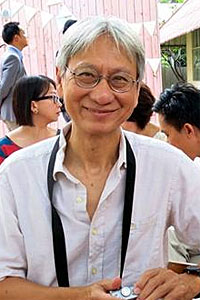We're inching toward the day of reckoning, so it seems. Everyday there's a battle, and the Din Daeng Triangle is the battle ground. At least for the past several days.
The landmark of the battle ground is a row of freight containers. This has been erected across the outbound lane of Vibhavadi Rangsit highway, originally to prevent a procession of protesters from reaching the residence of the prime minister at the 1st Infantry Regiment on Phahon Yothin Road.
Enraged by the blockade, a small breakaway group of protesters took to spraying profanities on it with paint, throwing objects at it and trying to bring it down. That led to riot police behind the iron wall launching a counterattack with tear gas and water cannons, followed by rubber bullets.
The scene would be repeated with increasing intensity for the next several days. A new development is that the police stopped issuing warnings before launching their crackdowns as is normally stipulated in universally accepted anti-riot protocol.
The increasingly violent confrontations are limited to this small area, at least for now. But they could spread further afield if the authorities continue to employ a hardline approach against the protest movement.
Freight containers have become an essential part in the police's anti-protest arsenal. But they also represent a symbol of the chasm between the authorities and the people as well as a symbol of power run amok.
A wall such as this has no place in a functioning democracy. It's an admission of the fact that authoritarianism is what we have.
What are the risks of allowing a relatively small number of peaceful citizens to march to the residence of the country's leader to express their dissatisfaction?
The number of places where protests have been banned have grown to a ludicrously long list. They include, in addition to the PM's residence, Government House, all areas considered to be royal household boundaries, the Skywalk at Pathumwan intersection because it's near a palace, and even the symbol of democracy itself -- Democracy Monument.
The real objective of the government's hardline tactics is not to prevent people from gathering in public since we had witnessed in the past groups of people being freely allowed to show their support for the government or opposition to pro-democracy protests.
The real objective is to prevent people from freely expressing their opinions that are not in favour of the ruling regime.
Since the current government came to power seven years ago, it has never strayed away from exercising hardline power in the country's administration. It wants to hear or see no dissent, no matter how reasonable. Laws have been legislated to that effect.
This mindset is not much of a surprise considering the fact that the government is headed mainly by life-long military men who came to power through a coup d'état. During his seven years in power, Gen Prayut Chan-o-cha, the prime minister, has been unable to transition from being a military man to a civilian even after his retirement a few years back.
He and his comrades are firmly stuck in the past, unable to break free and see how far behind the world has left them.
It would not be much of a loss if they were the only ones to stay behind. Their mortal sin is that they behave like the freight container wall that keeps a generation of youth behind and prevents the country from going forward.
But, like the Berlin Wall, this container wall of infamy will one day be brought down by the will of the people.
The current social and economic turmoil, brought about by the Covid-19 pandemic, demands a leadership that is capable of bringing the country together to form a wall of a different kind against the virus scourge.
What we have instead is an incompetent regime with a leader who is incapable of admitting his own failings, who sees the country's suffering not as his own fault but the fault of the people.
This sad state of affairs cannot last long. Eventually, the cries of suffering and dissent will grow so loud that no wall can stand in the way.
It is this fear of inevitability that the container wall was put up in the first place. If a small group of marchers is allowed an unimpeded passage to make their voices heard, how much larger will they grow in the coming days?
Paradoxically, the wall will hasten the day of its own downfall.
